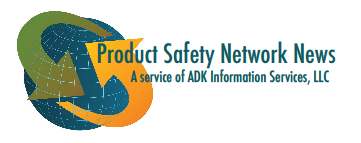85 million more Takata airbags may face recall
April 14, 2016, Time
There are still 85 million Takata airbag inflaters in American cars that the company may have to recall if their safety cannot be proven, the National Highway Traffic Safety Administration has said. Since 2014, 28 million cars have been recalled due to inflaters that have a tendency to explode and send metal or glass shrapnel shooting at car passengers. There are inflater links to 11 deaths and at least 100 injuries, the most recent event occurring several weeks ago, taking the life of a 17 year old.
California proposes Prop 65 MADL for ethylene glycol
April 15, 2016, National Law Review
The California Environmental Protection’s Office of Environmental Health Hazard Assessment proposed a Proposition 65 Maximum Allowable Dose Level (MADL) for oral exposure of 8,700 micrograms per day. Ethylene Glycol, a substance used in the production of several packaging materials, was added to the list of chemicals known to the State of California to cause reproductive toxicity under Prop. 65 on June 19, 2015.
Glyphosate: authorize for just seven years and professional use only, urge MEPs
April 13, 2016, European Parliament News
In a resolution passed by European Parliament Members, the EU Commission was urged to renew the marketing of glyphosate for seven years instead of 15 years, the usual term for such activities. MEPs call for an independent review of and the publication of all scientific evidence that the European Food Safety Authority used to assess glyphosate, which has sparked concern about the carcinogenicity and endocrine disruptive properties of the herbicide, used in many farm and garden applications. The MEPs urged the Commission to not approve any non-professional uses of glyphosate.
Research Report: Regulations tied to product quality that will fuel growth of baby walker market through 2020
April 13, 2016, Marketwatch
Emphasis on improving product quality is a key trend predicted to accelerate growth of the Global Baby Walker Market, expected to reach USD 1.11 billion by 2020, according to a report by Technavio. The report notes “With strict mandatory government rules and regulations involving the manufacture of baby products like baby walkers being implemented around the globe, especially in developed countries, it has become imperative for the key players in this market to develop improved quality products that comply with all the rules and regulations. As a result, there has been an influx of high quality products which is set to fuel the market’s growth over the next five years,” the report states.
Commissioners Views: Commissioner Marietta Robison posts a joint blog with Commissioner Ann Marie Buerkle on 2016’s celebration of National Women’s History Month
March, 2016, cpsc.gov
The Commissioner noted that “Commissioner Buerkle and I were confirmed together by the U.S. Senate in 2013, and are currently the only women CPSC Commissioners.” She mentioned the panel that the two of them shared at the 2016 International Consumer Product Health and Safety Organization (ICPHSO) annual symposium. “Many times during our discussion we vehemently disagreed and other times we genuinely agreed, but our conversation was thoughtful, substantive and respectful,” she observed
Fixation on product approval has to go: FSSAI chief
April 13, 2016, livemint.com
In the case of proprietary food products, if ingredients are the same, there should not be any need for product approval every time, according to India’s Food Safety and Standards Authority CEO, Pawan Kumar Agarwal. His plan for ensuring food safety includes a focus on standards, as well as training, disseminating manufacturing best practices, hygienic practices, and hazard analysis and control and critical control points. He says that India’s standards “will have to be globally benchmarked. We cannot have different national and international standards, as it will create problems in import and export.”
Identifying chemicals at ports: New system claims efficiency and safety for detection
April 11, 2016, labmate-online.com
A company has introduced a new handheld system that it says identifies hazardous materials through non-metallic sealed containers and applicable for Hazmat incident management, military EOD, first response, search and law enforcement and screening at port and borders. The system uses a spectroscopy technology to detect individual chemicals and mixtures through barriers such as plastics, paper, card, sacks, fabric and glass.
Water Safety USA Launch
April 12, 2016, Reuters
A consortium of national governmental and non-governmental organizations concerned with water safety aims to empower people with resources, information, and tools to more safely enjoy and benefit from aquatic environments. The group hopes to help align various public safety messages and information from different sources to simplify its content and make the messages more effective. The U.S. Consumer Product Safety Commission spearheads the federal government’s largest campaign in drowning prevention.
What your business needs to know about product traceability
April 12, 2016, Australian Food Network
If a business can get safety and traceability right, the public will have faith in them, a powerful position in a world where consumer confidence and brand loyalty are increasingly fragile. So what is traceability, and what do you need to know to achieve it?
New sensors help reduce supply chain risks
April 13, 2016, cso.com.au
Better sensors help companies reduce shipping risks and react faster to disruptions, but costs and deployment challenges are still slowing adoption. A survey of 337 executives from large global manufacturing and retail organizations revealed that only 15 percent said that the majority of data from the extended supply chain is accessible to them, but in 5 years that number jumps to 54 percent.


